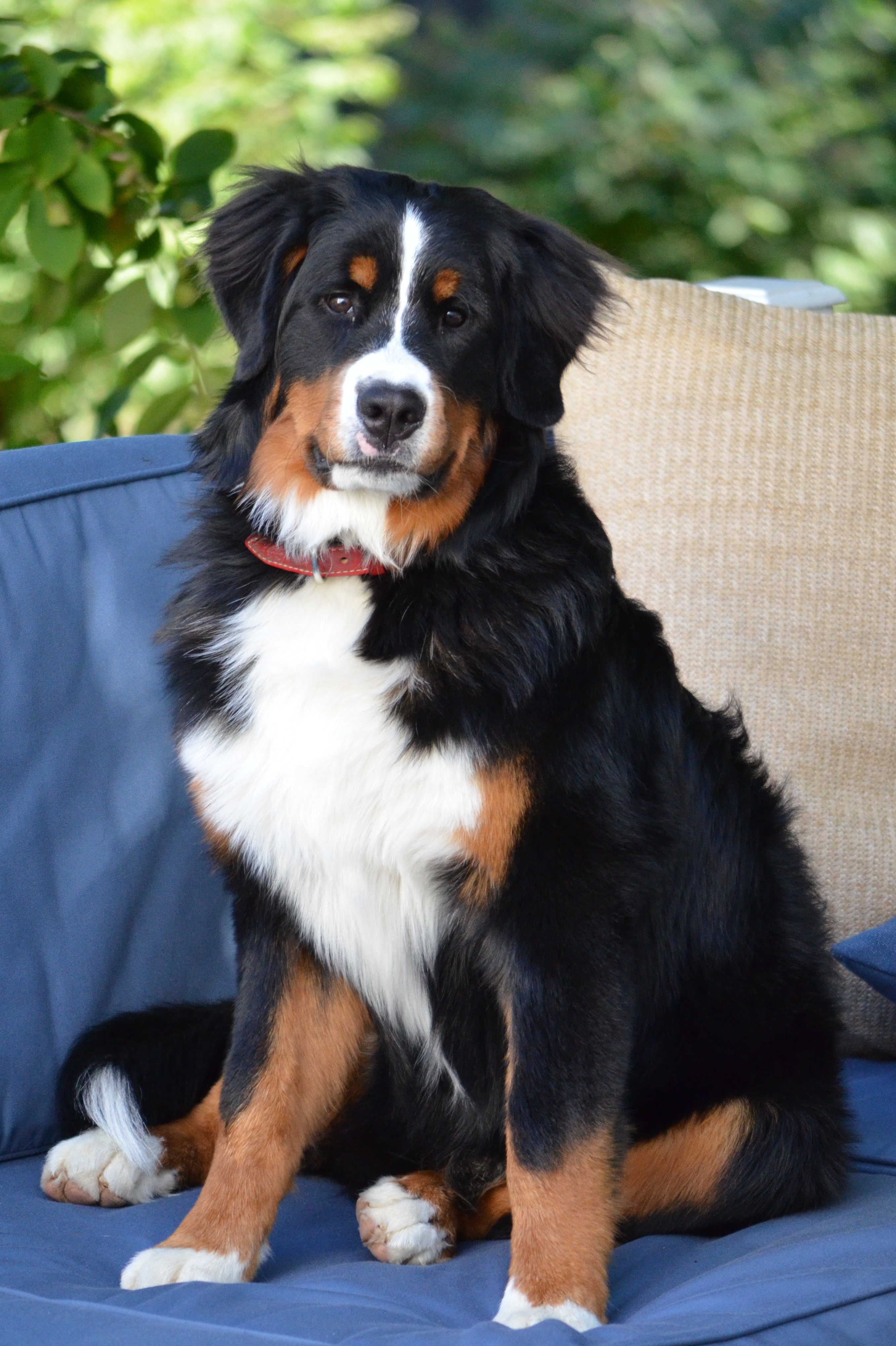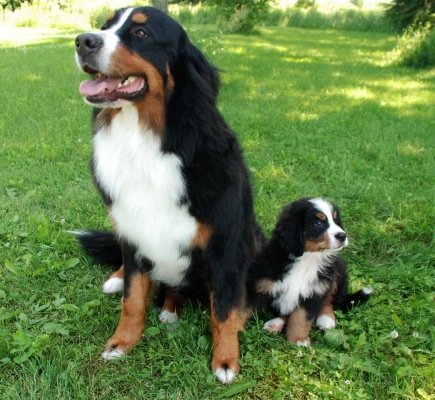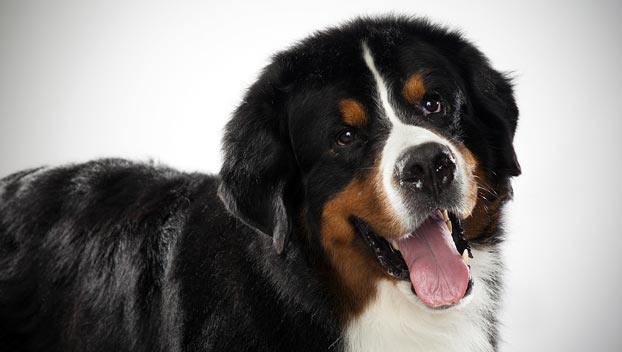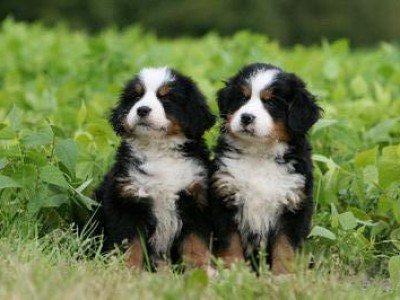
The Breed History
Originating in the middle cantons of Switzerland (Berne region), this
hardy dog was likely brought to the Alps by the Romans. These dogs
derive from ancient Mastiff-type dogs. Almost lost to extinction,
rejuvenation of the breed began in the 1900s. Out-crossing to
Newfoundland dogs was one of the steps taken to infuse fresh
genes. The first dogs were brought to America in 1926, and first
AKC recognition was in the year 1937.
Breeding for Function
The Bernese Mountain dog acted as a drover and guarding dog and
also for draft; pulling carts. They are unusually hardy and can live in
environments with extremes of temperature and terrain. Today, they
are seen in obedience, tracking, agility, and as therapy dogs. They
are valued companions.
Physical Characteristics
Height at Withers: female 23-26" (58.5-66 cm), male 25-27.7"
(63.5-70 cm).
Weight: females 75-95 lb (34-43 kg), males 80-115 lb (36-52 kg).
Coat: The silky, glossy, thick, straight to slightly wavy and
moderately long coat distinguishes this breed from the other Swiss
Mountain Dogs. Color is a jet black background with well defined
rust markings and white highlight markings for the standard; the
tri-color pattern has established marking distribution. Notably, the
chest markings in white forms the Swiss cross and a white blaze is
usually present. White is also found on the paws and tail tip. When
they blow the coat twice per year, heavy shedding occurs; some
dogs are low-level shedders year-round.
Longevity: 7-9 years
Points of Conformation: Sturdily built, large, but agility has
not been compromised. Heavy bone and musculature are bred
into these dogs. The eyes have a gentle expression and are a dark
brown, oval shaped and have tight fitting eyelids. Ears are high set,
triangular and hang close to the cheek. The skull has a moderate
stop and a slight furrow runs up along the midline. The square
muzzle ends in a large black nose. Lips are free of flews; they are a
dry-mouthed breed. Neck is of medium length, well muscled and
the topline is level. The thorax is deep and possesses well-sprung
ribs. The tail is carried low when resting and is heavily haired. It
reaches to the tarsus or a bit lower. Legs are straight boned, and
dewclaws may be removed. Feet are compact and the toes are well
arched. Rear dewclaws are removed.
Recognized Behavior Issues and Traits
Reported breed characteristics include: Faithful, gentle, affectionate,
quick learner, hardy, needs close human companionship, may be
aloof with strangers, need adequate exercise. Some lines may have
temperament quirks. Good with other children and animals. Low
barking, though will alarm bark. They need early socialization and
obedience training, and are moderately active. Bernese are sensitive
dogs; they respond best to gentle firm correction.
Normal Physiologic Variations
Mountain dogs are slow to mature, so should not be asked to do
strenuous activity or pull heavy loads before they reach 2-3 years
of age.
According to the 2005 BMDCA Health Survey, 59% of breeding
females have had at least one C-section, and 32% have had
difficulty whelping a litter.
A Danish study of Bernese Mountain Dogs suggests that the breed
may have higher normal ranges for biochemical values, including:
Alkaline Phosphatase/AlkP (0-464), g-glutamyltransferase (0-12.2),
amylase (285-1255), and cholesterol (5.29-10.08).
Drug Sensitivities
None reported
Inherited Diseases
Elbow Dysplasia: Polygenically inherited trait causing elbow
arthritis. Studies have shown that a significant portion of Bernese
Mountain Dogs with elbow dysplasia have fragmented medial
coronoid process. Males have a 3.1x risk over females in the breed.
Breeding studies show a heritability of 20%, and that dogs with
all grades of elbow dysplasia have the same liability for producing
the disease in offspring. OFA reports 29.0% affected. Reported at
a frequency of 24.5% in the 2005 BMDCA Health Survey. Reported
140.1x odds ratio for fragmented coronoid process, and 50.5x odds
ratio for ununited anconeal process forms of elbow dysplasia versus
other breeds.
Hip Dysplasia: Polygenically inherited trait causing degenerative
joint disease and hip arthritis. Reported 7.2x odds ratio versus other
breeds. OFA reports 16.0% affected. Reported at a frequency of
14.0% in the 2005 BMDCA Health Survey.
Patella Luxation: Polygenically inherited laxity of patellar ligaments,
causing luxation, lameness, and later degenerative joint disease.
Treat surgically if causing clinical signs. OFA reports 3.2% affected.
von Willebrand's Disease Type 1 (vWD): Autosomal recessive
genetic disorder causing a mild bleeding syndrome. A direct genetic
test is available from VetGen, reporting 1% affected, and 16%
carrier in the breed.
Progressive Retinal Atrophy (PRA): An autosomal recessive
early retinal degeneration is identified in the breed, with an onset
of night blindness around one year of age. Identified in 0.12% of
Bernese Mountain Dogs CERF examined by veterinary ophthalmologists
between 2000-2005, with an additional 0.24% labeled
suspicious for PRA. Confirm with an electroretinogram. A genetic
test is not available. CERF does not recommend breeding any
Bernese Mountain Dog with PRA.
Juvenile Renal Dysplasia: Rare, membranoproliferative
glomerulonephritis with concomitant interstitial nephritis. Affected
dogs present initially with polyuria and polydipsia, which progresses
to clinical renal failure. Affected dogs are identified from months of
age to 2-7 years of age. The renal expression of megalin is reduced or
completely absent. One study suggests an inherited susceptibility to
Borrelia infection as a precipitating factor. The mode of inheritance
is polygenic, with a major autosomal recessive gene, and possibly an
additional sex-linked gene influencing its expression.
Hepatocerebellar Degeneration: A rare, autosomal recessive
disease seen in 4-6 week old Bernese Mountain Dogs characterized
by progressive cerebellar and hepatic disease. Histologically,
degeneration and depletion of Purkinje's cells and vacuolation,
degeneration, and nodular regeneration of hepatic tissues are
evident.
Disease Predispositions
Mortality/Longevity: Bernese Mountain Dogs are found to have
diminished longevity, with a yearly breed-specific mortality risk of
6.5%. The probability for survival by 5 years of age is 83%, and by
ten years of age is 30%. The 2005 BMDCA Health Survey found
an average age at death of 7.8 years. A danish study showed an
average life span of 7.1 years. Mortality studies in Sweden show
a significantly increased risk of death due to tumors, especially in
male dogs, versus other breeds.
Umbilical Hernia: Congenital umbilical hernias are reported at a
frequency of 24.0% in the 2005 BMDCA Health Survey.
Osteoarthritis: Bernese Mountain Dogs have an increased
incidence of arthritis. Dorn reports a 1.58x odds ratio versus other
breeds. Reported at a frequency of 17.0% in the BMDCA 2005
Health Survey, with an average age of onset of 5.5 years.
Allergic Dermatitis (Atopy): Inhalant or food allergy. Presents
with pruritis and pyotraumatic dermatitis (hot spots). Reported at a
frequency of 16.0% in the 2005 BMDCA Health Survey.
Panosteitis: A self-limiting disease of young, large breed dogs
involving the diaphyseal and metaphyseal areas of the tubular
long bones, characterized by medullary fibrosis and both endosteal
and subperiosteal new bone deposition. Affected dogs show
intermittent lameness. Treatment is with non-steroidal anti-inflammatory
drugs and rest. Reported at a frequency of 7.3% in the 2005
BMDCA Health Survey, with an average age of onset of 1.1 years.
Cranial Cruciate Ligament Rupture (ACL): Traumatic tearing of
the anterior cruciate ligament. Treatment is surgery. Reported at
a frequency of 7.3% in the 2005 BMDCA Health Survey. Unknown
mode of inheritance.
Malignant Histiocytosis: The breed is predisposed to develop
malignant histiocytomas in any area of the body. The most common
clinical signs are anorexia, weight loss, lethargy, anemia, and
dyspnea and/or coughing. Radiographs in affected dogs usually
reveal either pulmonary nodules or consolidation, mediastinal mass,
pleural effusion, or hepatomegaly and splenomegaly. The average
age of diagnosis is 6.5 years, with an average life expectancy
post-diagnosis of 49 days. Dorn reports a 15.07x odds ratio for
the disorder versus other breeds. The trait appears to have a major
Mendelian gene in its transmission, with a heritability of 0.298.
One study in France reported an affected frequency of up to 25%.
Reported as the cause of death of 10.7% of Bernese Mountain Dogs
in Denmark at an average age of 6.9 years. Reported at a frequency
of 4.0% in the 2005 BMDCA Health Survey, though listed as the #1
cause of death.
Hypothyroidism: Inherited autoimmune thyroiditis. 4.8% positive
for thyroid auto-antibodies based on testing at Michigan State
University. (Ave. for all breeds is 7.5%). Reported at a frequency of
7.0% in the 2005 BMDCA Health Survey.
Cataracts: Anterior cortex punctate cataracts predominate, through
posterior, nuclear, and capsular cataracts also occur in the breed.
Age of onset at 1 year. Identified in 4.03% of Bernese Mountain
Dogs CERF examined by veterinary ophthalmologists between
2000-2005. Reported at a frequency of 4.7% in the 2005 BMDCA
Health Survey. CERF does not recommend breeding any Bernese
Mountain Dog with a cataract.
Idiopathic Epilepsy: Grand-mal or petit-mal (partial) seizures
are seen in this breed, with an average onset of 1-3 years of
age. There is a male predominance. Treat with anticonvulsant
medication. Pedigree studies in the breed indicate a polygenic
mode of inheritance for grand-mal seizures, with the influence of
a major recessive gene. Fly-Biting Petit-Mal Seizures are reported
at a frequency of 4.0%, and Grand-mal seizures are reported at a
frequency of 1.9% in the 2005 BMDCA Health Survey.
Gastric Dilatation-Volvulus (Bloat, GDV): Polygenically inherited,
life-threatening twisting of the stomach within the abdomen.
Requires immediate veterinary attention. Reported at a frequency
of 4.0% in the 2005 BMDCA Health Survey, with an average age of
5 years, and a 23% fatality.
Persistent Pupillary Membranes: Strands of fetal remnant
connecting; iris to iris, cornea, lens, or involving sheets of tissue.
The later three forms can impair vision, and dogs affected with
these forms should not be bred. Identified in 3.49% of Bernese
Mountain Dogs CERF examined by veterinary ophthalmologists
between 2000-2005.
Mast Cell Tumor (MCT): Skin tumors that can reoccur locally or
with distant metastasis. Mast cell tumors produce histamine, which
can cause inflammation and ulceration. Reported at a frequency of
3.0% in the 2005 BMDCA Health Survey.
Lymphoma/Lymphosarcoma: Malignant lymphatic cancer that
most commonly presents in the lymph nodes, spleen, liver, or heart.
Reported at a frequency of 3.0% in the 2005 BMDCA Health Survey.
Humeral Osteochondritis Dissecans (OCD): Polygenically inherited
cartilage defect of the humeral head. Causes shoulder joint pain
and lameness in young growing dogs. Mild cases can resolve with
rest, while more severe cases require surgery. 2.24:1 male to female
ratio in the breed. Age of onset usually 2-4 months. 50% of cases
are bilateral. Reported 47.1x odds ratio versus other breeds. Dorn
reports a 4.40x odds ratio for OCD versus other breeds. Reported at
a frequency of 2.9% in the 2005 BMDCA Health Survey. Unknown
mode of inheritance.
Entropion: Rolling in of eyelids, often causing corneal irritation
or ulceration. Entropion is reported in 1.89% of Bernese Mountain
Dogs CERF examined by veterinary ophthalmologists between
2000-2005. Reported at a frequency of 2.4% in the 2005 BMDCA
Health Survey.
Cleft Palate: Congenital disorder of incomplete closure of the
maxillary processes to form the roof of the mouth. Reported as the
#1 most frequent birth defect in the 2005 BMDCA Health Survey.
Susceptability to Borrelia (Lyme disease) Infection: European
studies have shown a higher frequency of either clinical Borreliosis
or high Borrelia antibodies in Bernese Mountain Dogs compared
with other breeds, suggesting an inherited increased susceptibility
to infection.
Portosystemic Shunt (PSS, lLiver Shunt): Congenital abnormal
blood vessel connecting the portal and systemic circulation. More
frequently intrahepatic in this breed versus extrahepatic. Causes
stunting, abnormal behavior, possible seizures, and secondary
ammonium urate urinary calculi in the breed. Treatment of PSS
includes partial ligation and/or medical and dietary control of
symptoms. Tobias reports a 15.1x odds ratio versus other breeds.
Necrotizing Vasculitis/Sterile Meningitis: Affected dogs
present with apathy, fever and increased head and cervical pain.
Histopathology shows necrotizing vasculitis in the CNS, with
perivascular granulomatous inflammation. Treat with steroids.
Unknown mode of inheritance.
Degenerative Myelopathy (DM): Affected dogs show an insidious
onset of upper motor neuron (UMN) paraparesis. The disease
eventually progresses to severe tetraparesis. Affected dogs have
normal results on myelography, MRI, and CSF analysis. Necropsy
confirms the condition. Reported at a 4x odds ratio versus other
breeds. Unknown mode of inheritance. A direct genetic test for
an autosomal recessive DM susceptibility gene is available. All
affected dogs are homozygous for the gene, however only a
small percentage of homozygous dogs develop DM. OFA reports
DM susceptibility gene frequencies of 49% carrier, and 11%
homozygous "at-risk".
Hypomyelination of the Spinal Cord (Trembler): The condition
is manifested clinically as a tremor of the limbs and head which
becomes more intense with excitement or stress and which
disappears with sleep. The tremor, which is first noticeable between
two and eight weeks old, may persist throughout life but decline
with age. An autosomal recessive mode of inheritance is suggested.
Cervical Vertebral Instability (Wobbler Syndrome): Presents
with UMN spasticity and ataxia. Imaging studies suggest that the
primary lesion is foramenal stenosis and intervertebral instability at
C3-7. MRI is superior to myelography in determining site, severity,
and nature of the spinal cord compression. Treatment is with
surgery. Undetermined mode of inheritance. Reported as a sporadic
finding in the breed.
Rosenthal Fiber Encephalopathy (Alexander's Disease): Fatal,
neonatal degenerative neurological disease presenting with rapidly
progressive nonambulatory tetraparesis, generalized tremors, and
depressed mental status. Macroscopically the brain shows moderate
enlargement of the lateral ventricles. Histologically there are GFAP
positive staining eosinophilic deposits consistent with Rosenthal
fibers (RFs) throughout the white matter of the central nervous
system, and a marked proliferation of abnormally large astrocytes.
Color Dilution Alopecia, Fibrinoid Leukodystrophy, Hypertrophic
Osteodystrophy, Hypoadrenocorticism, and Sebaceous Adenitis
are reported.
Isolated Case Studies
Cervical Cartilaginous Exostosis: A 3-1/2 year old Bernese
Mountain Dog exhibited ataxia in the hind limbs and flailing
movements in the forelimbs. On survey radiographs of the cervical
spine there was a focal calcified mass between the dorsal arch of
the atlas and the spinous process of the axis with severe dorsal
spinal cord compression. The mass was removed surgically and the
dog made a complete recovery. Histopathology of the excised mass
was consistent with a diagnosis of cartilaginous exostosis.
Circumcaval Ureter and Intrahepatic Portosystemic Shunt: A
4-month-old Bernese Mountain Dog had an intrahepatic shunt,
and hydronephrosis and hydroureter due to the left ureter passing
dorsal to the caudal vena cava. The shunt was partially closed with
a cellophane band, and the ureter repositioned ventral to the vena
cava, and anastomosed.
Nephroblastoma: A 4-month-old female Bernese Mountain
Dog examined for abdominal distention was found to have a
nephroblastoma. The dog was euthanized due to widespread
metastasis.
Fibromatosis: A young, male Bernese Mountain Dog with lameness
and diffuse thickening of the soft tissue in the right hind limb,
was found to have multilobular, space-occupying lesions within
and between the muscles of the right femur. Pathology identified
collagen fibers and fibroblasts, and a diagnosis of fibromatosis.
Genetic Tests
Tests of Genotype: Direct test for vWD is available from VetGen.
Direct test for a DM susceptability gene is available from the OFA.
Tests of Phenotype: CHIC Certification: Required testing includes
AKC DNA profile, vWD test from VetGen, hip and elbow radiographs,
CERF eye examination, and cardiac evaluation by a cardiologist. (See
CHIC website; caninehealthinfo.org).
Recommend thyroid profile including autoantibodies, patella
evaluation and bile acids or blood ammonia for liver shunt.
Miscellaneous
- Breed name synonyms: Berner Sennenhund, Berner, Bernese
Cattle Dog, Durrbachler (historical).
- Registries: AKC, UKC, CKC, KCGB (Kennel Club of Great Britain),
ANKC (Australian National Kennel Club), NKC (National Kennel Club).
- AKC rank (year 2008): 40 (3,338 dogs registered)
- Internet resources: Bernese Mountain Dog Club of America:
bmdca.org
Bernese Mountain Dog Club of Canada: bmdcc.ca
Bernese Mountain Dog Club of Great Britain:
bernese.co.uk
Berner-Garde Foundation: bernergarde.org
Photo Gallery of Breed - Bernese Mountain Dog - Dog Breed








 Animalia Life
Animalia Life